Pontypridd Urban District Council Tramways
History
Pontypridd Urban District Council first obtained powers to build and operate a 3ft 6ins-gauge electric tramway in August 1901, but ended up having to go back to the Lords twice more to get all the lines approved that it needed (in August 1902 and July 1903), due not only to vested interests, but also to serious opposition from within the town.
Construction commenced in July 1903, but of necessity excluded the Pontypridd and Rhondda Valley horse tramway, which was owned by the British Electric Traction Company, whose own plans for electric working had been undone by council objections. It was to take another 15 months before Pontypridd and Rhonda Urban District Councils completed the purchase of the horse tramway — on the 31st October 1904 — after which its conversion could begin, it having been closed since July 1903.
Electric services commenced on the 5th March 1905, though the system was not completed until 1907. At its greatest extent, it totalled 5.34 miles, comprising lines running: northwestwards to Trehafod; northeastwards to Cilfynydd; and southeastwards to Treforest. Although the system was connected at Trehafod to the Rhondda UDC Tramways from 1908 onwards (operated by the Rhondda Tramways Company), it was not until the 14th July 1919 that through running commenced (between Pontypridd and Porth) only to stop again in December 1927, both parties managing to disagree on just about everything in the 8 years that the services ran.
The system was saddled with a huge debt from the outset, the UDC having not only paid about 50% greater construction costs than similar hilly systems elsewhere on the British mainland, but also building, rather unnecessarily, an electricity generating plant. The tracks were also subject to severe subsidence — from mining — so track maintenance was a constant and ever-present expense. Despite this, receipts exceeded expenses (which were the second highest in the country at one point) in every year bar one, even though the trams did not run on Sundays until 1926; crucially however, takings were not high enough to adequately service the debt, the council taking until 1940 to finally pay it off.
Like most systems, the PUDCT emerged from the Great War in badly run-down condition, with a huge backlog of repairs and renewals. Despite the challenging post-war financial climate, the council managed to find the money to carry out major track renewals, buy five new tramcars and even expend over £2000 on powers for an extension to Upper Boat that was subsequently not built. The council was clearly proud of its municipal tramway, and was determined to keep it running irrespective of the high costs, even turning down an approach — in October 1923 — from the neighbouring Rhondda Tramways Company to operate the system for them.
Despite the bus competition of the 1920s, and the general downturn in the economy, the tramway continued to carry 400,000 to 500,000 passengers per month during the 1920s, though it was badly impacted by the coal strike of 1921 and the national strike of 1926. By 1928 however, with the tramcar fleet in need of replacement, and with ever-spiralling track maintenance costs, the council decided to seek powers to run buses and trolleybuses, these being granted on the 10th May 1929.
The decision to operate trolleybuses was no doubt heavily influenced by the fact that the council owned the electricity generating facility, though in the end, only the Treforest to Cilfynydd section was converted, as the RTCo declined to switch their line beyond Trehafod to this form of traction. The trolleybuses commenced operation on the 16th September 1930, though it was to be a while before their numbers were sufficient to work the line at peak times, so the trams (as well as buses) continued in a supplementary role for a short while.
The last tram of all — on the Rhondda line to Trehafod — ran on the 30th August 1931, the service being replaced by buses.
Uniforms
For some reason now lost in the mists of time, Pontypridd UDC apparently saw fit not to issue uniforms to its tramcar staff, only agreeing to provide waterproof clothing in 1906 — a year after opening — with tunics and greatcoats following as late as 1908/9. Early photographs do however show smartly attired staff, suggesting that although they were not provided with uniforms by the UDC, they were nevertheless expected to wear smart jackets, no doubt self funded. These early jackets therefore bore neither marked buttons nor insignia (see first photo below). The only badge of office appears to have been the tensioned-crown peaked caps, which were presumably provided by the UDC; they bore standard, off-the-shelf, script-lettering grade badges — either 'Conductor' or 'Motorman' — probably in brass.
Following the UDC's decision to provide official uniforms, motormen were issued with double-breasted lancer-style tunics with five pairs of buttons (narrowing from top to bottom, and presumably bearing the UDC title and a depiction of Pontypridd bridge — see link), with stand-up collars and epaulettes. It is unclear what jackets conductors were provided with, but by the mid 1920s they were wearing single-breasted jackets with five buttons, stand-up collars and epaulettes (with button closures). The collars on all the jackets bore insignia of some kind, probably system initials on one side and an employee number on the other, though these cannot be made out with certainty on the surviving photographs. In the late 1920s, the grade badges were supplemented with a large municipal cap badge comprising the full council name around a depiction of Pontypridd bridge, all within a wreath. These were presumably issued in brass.
Greatcoats were double-breasted with five pairs of buttons and high, fold-over collars; they appear to have been totally devoid of insignia.
In common with tramcar staff, inspectors also appear to have had to buy their own clothing, so jackets, although smart, were initially devoid of insignia. Later on, inspectors were issued with standard tramway uniforms for this grade, comprising single-breasted jackets with hidden buttons (or more likely a hook and eye affair), all edged in material of a finer quality than the main jacket. The jackets had stand-up collars which bore the grade 'Inspector' in embroidered script lettering. The tensioned-crown peaked caps bore a script-lettering 'Inspector' badge on a hat band, again probably embroidered.
Conductresses were first employed in late 1915 (during the Great War) to replace male staff lost to the armed services, as well as to the collieries, which paid higher wages than the tramway. These ladies were issued with long, tailored, lancer-style top coats with five pairs of buttons (narrowing from top to bottom) and high, fold-over collars; the collars and cuffs were embellished with piping; these garments carried no badges. The coats were worn with breeches (hidden by the long top coat) and gaiters. Large felt bonnets were issued, which were piped to match the coat, and like the latter, they also appear to have been devoid of insignia. Unlike the vast majority of UK tramway systems, Pontypridd retained its conductresses well beyond the end of the war, only parting company with the last of them in 1926.
Further reading
For a history of Pontypridd's tramways, including the earlier horse tramway, see 'Passenger Tramways of Pontypridd' by R Large; Oakwood Press (1977).
Images
Motormen and conductors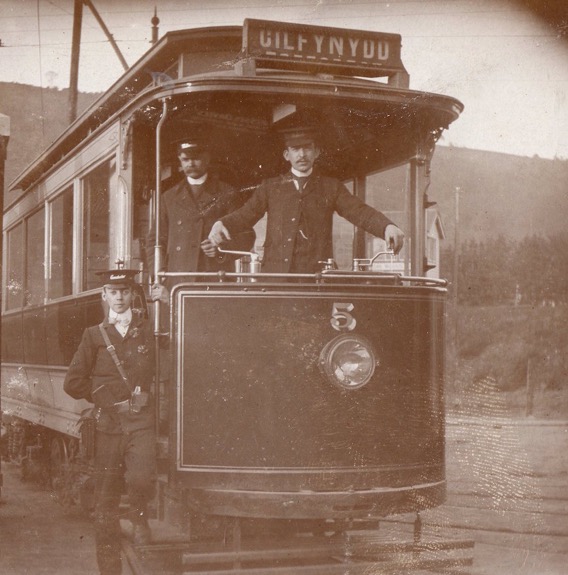
A conductor, a motorman and an inspector (at the controls) pose with what is probably a brand-new Tramcar No 5, dating the photograph to 1905. Author's Collection.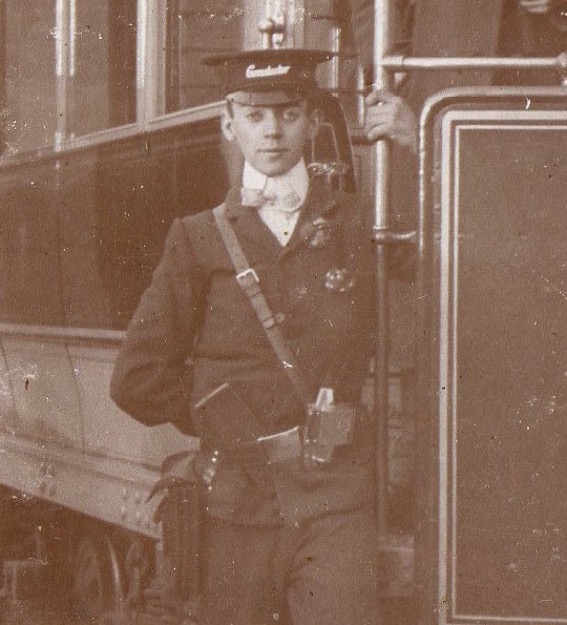
An enlargement of the above photograph showing the youthful conductor. Although smartly dressed, he appears to be wearing informal attire without insignia, apart from the cap and cap badge.
Standard off-the-shelf script-lettering grade badges, of the type used by Pontypridd. It is likely, though by no means certain, that these were issued in brass. Author's Collection.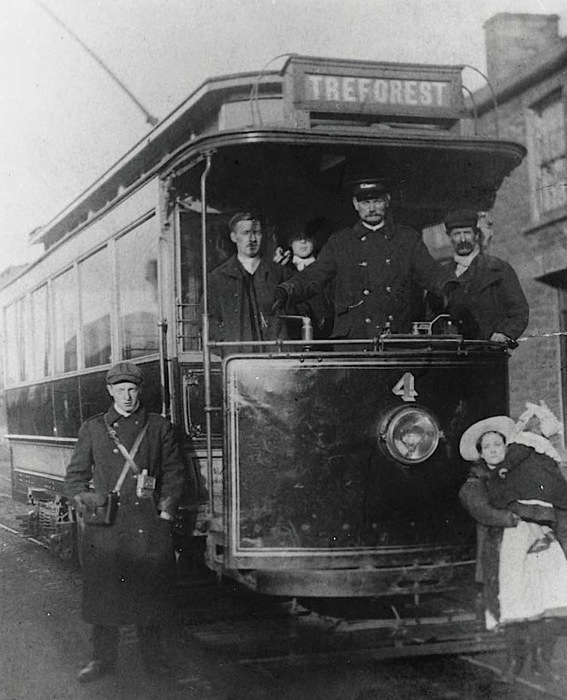
The crew of Treforest-bound Tramcar No 4 — photo undated, but possibly taken in 1908/9 given that the men appear to be wearing officially issued greatcoats. The conductor — William White — is wearing a flat cap. Photo courtesy of the Tramways and Light Railway Society; background information courtesy of 'Gathering the Jewels' (see link).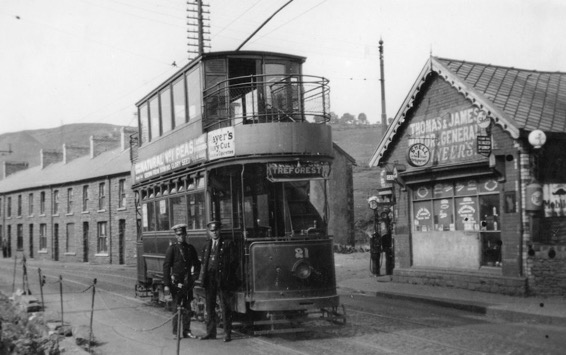
The crew of Tramcar No 21 at Cilfynydd terminus in 1930.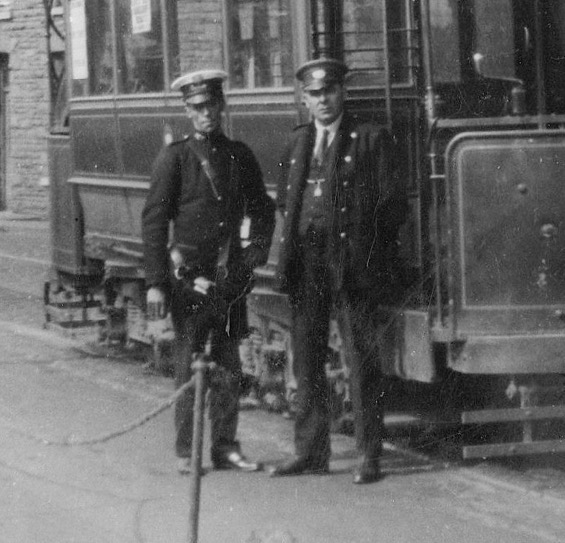
An enlargement of the above photograph showing the conductor and the motorman. The conductor is wearing a script-lettering grade badge, along with a large badge comprising a municipal device within a wreath (see below); the motorman's cap, on the other hand, is without a grade badge.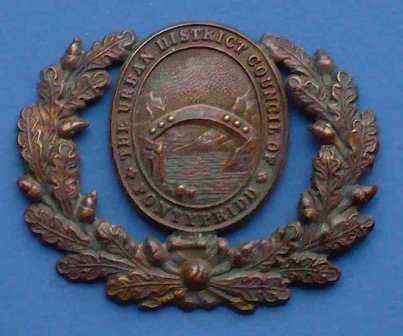
Pontypridd Urban District Council cap badge of the type issued to tramways staff from the mid-to-late 1920s onwards — brass. Author's Collection.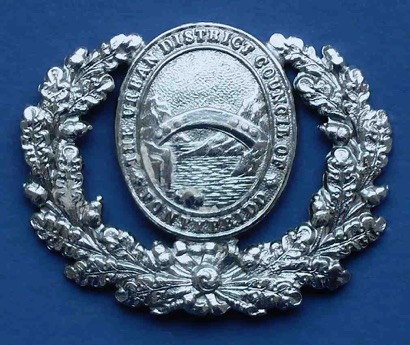
Although identical to the brass badge shown above, this chrome issue almost certainly post-dates the demise of the tramway (1931), so was presumably used on the council buses and trolleybuses. Author's Collection.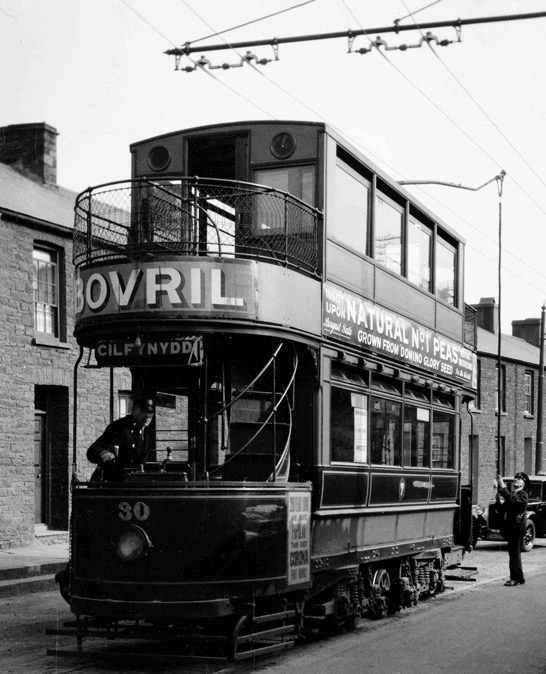
Pontypridd UDC Tramways Tramcar No 30 — photo purportedly taken on the 29th August 1930. Given that the conductor is turning the trolley pole, the location is possibly the terminus at Cilfynydd. Photo by Dr H Nicol, courtesy of the National Tramway Museum. 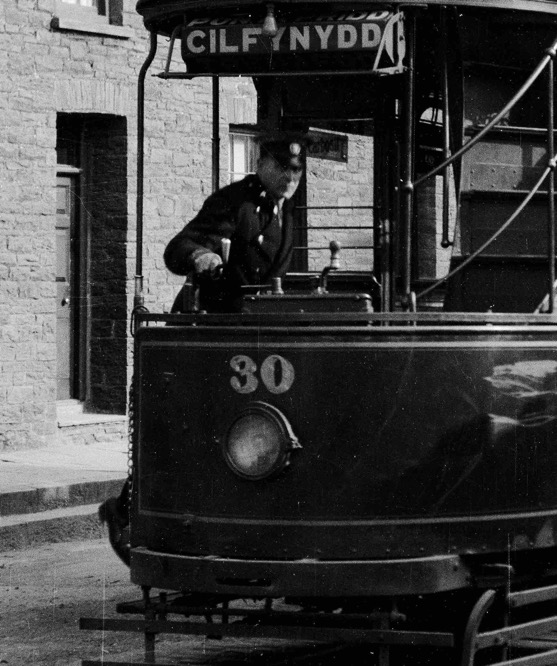
An enlargement of the above photograph showing the motorman. Despite the fact that he has moved during the exposure, his cap clearly carries the new municipal cap badge.
Senior staff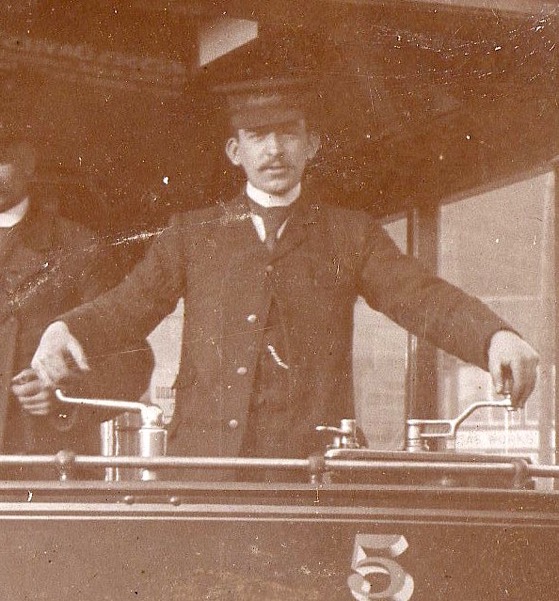
An enlargement of the 1905 photograph at the top of the page showing the inspector. Like the tramcar staff, he appears to be wearing smart but probably self-funded attire (i.e., not officially issued). His cap appears to bear a script-lettering grade badge — 'Inspector' — almost certainly embroidered.
Female staff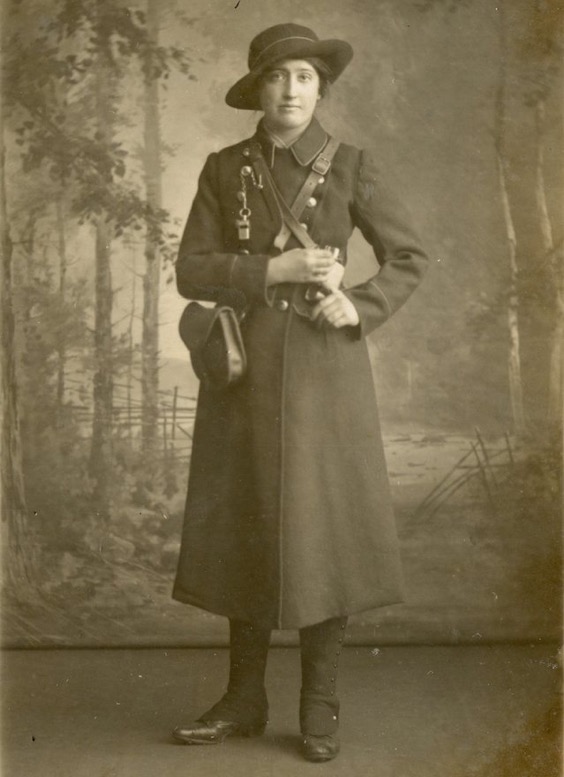
A studio portrait of a lady who is believed to be a Pontypridd Urban District Council Tramways conductress — photo dated 1918. The photograph was taken in the Studios of Dura Ltd, a company which had several premises in South Wales. Author's Collection.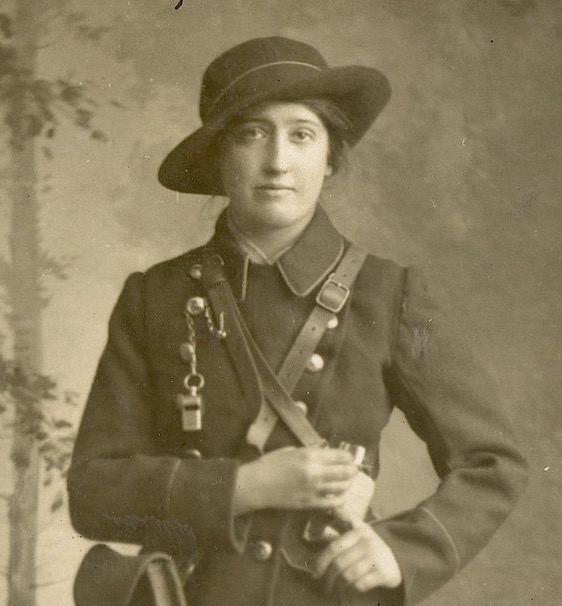
An enlargement of the above photograph revealing the uniform, which although of high quality, appears to be completely devoid of insignia.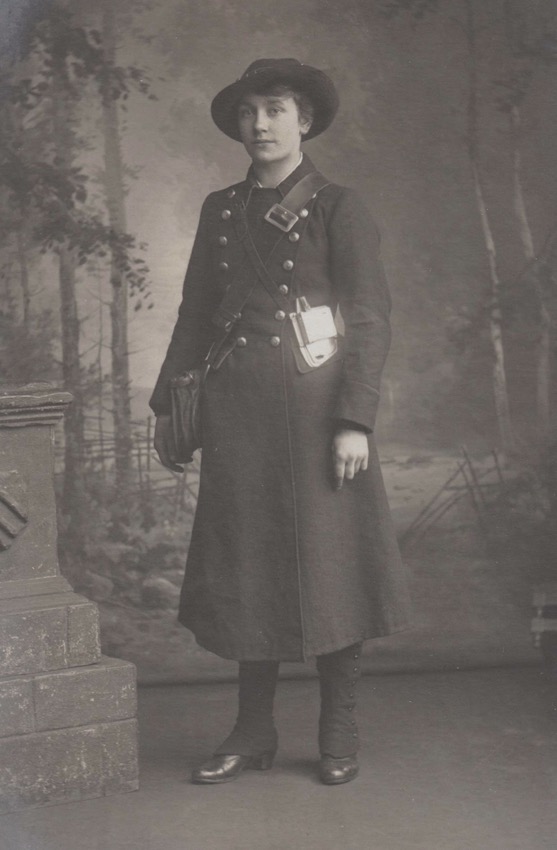
Another studio portrait of a PUDCT Great War conductress, taken in 1918 in the same studio (Dura) as the previous photograph. This time the back of the card has the name of the subject: Conductress Murphy. Author's Collection.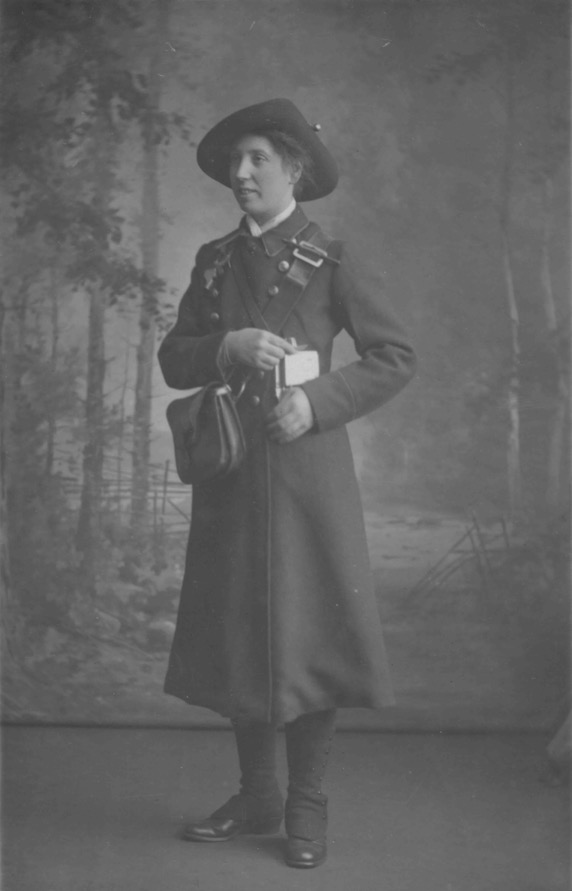
Yet another photo taken in the same studio, with the same backdrop, once again showing that the uniform, although very smart, did not bear any badges. Author's Collection.